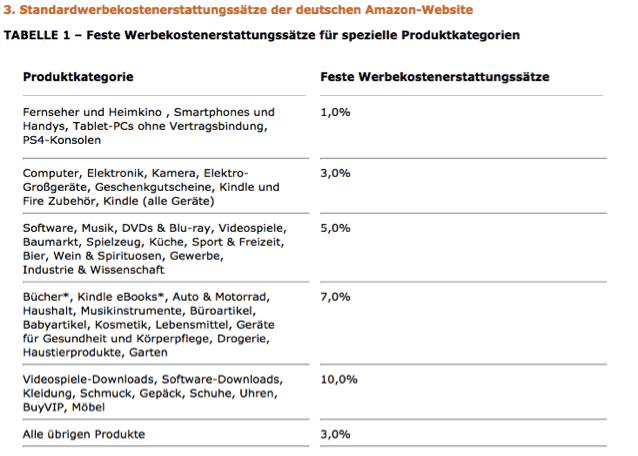After introducing affiliate marketing and the different tracking methods in the first two articles, we will now talk about the different commission models.
Below we take a look at the commission models pay-per-sale, pay-per-lead, pay-per-click and the lifetime commission model.
Pay-per-sale
The basic idea when affiliate marketing was launched in 1997 was to pay affiliates who direct a visitor to the merchant's website and make a purchase there a commission depending on the product sold and the value of the shopping cart. This type of remuneration model is known as pay-per-sale and is still one of the most widely used commission models in affiliate marketing today. The amount of commission depends on several variables and can therefore result in different levels of commission. One decisive variable is the product category of the advertised product. The different commissions are best illustrated using the Amazon affiliate program as an example.

Furthermore, some partner programs have so-called commission intervals. This means that the percentage commission increases when an interval is reached. The motivation behind this model is that affiliates are driven by higher commissions to focus more on the advertised products and that successful affiliates are rewarded with higher commissions.
In principle, standardized commission rates can be defined for certain product categories. Travel providers offer a relatively low affiliate commission of 2.5 to 5%. For digital products such as music, DVDs, but also books and clothing, commissions range from 5-15%. Software providers probably pay the highest commissions with up to 22%.
Pay-per-lead
In conventional marketing, a lead is a potential new customer. In affiliate marketing, the pay-per-lead method refers to the acquisition of qualified customer contacts through the affiliate's advertising measures. A qualified customer contact usually refers to the registration for the newsletter or the request for a catalog. The pay-per-lead method is offered as a remuneration method, particularly for the sale of products that require explanation and for the sale of contracts via the Internet. Possible providers of pay-per-lead procedures are insurance service providers, banks or mobile phone providers. With the pay-per-lead method, a fixed commission is often paid to the affiliate. The difference in the commissions offered also varies from industry to industry. In the mobile phone industry, up to €240 is paid per contract brokered. In the housing brokerage industry, a maximum pay-per-lead of €9 is paid for the placement of an advertisement.
Pay-Per-Click
With the pay-per-click method, the affiliate is remunerated for each visitor who is directed to the merchant's website by clicking on an advertisement. The performance-based action in pay-per-click is the only one in the affiliate marketing commission model that is not carried out on the merchant's website, but on the affiliate's website. Because it can be manipulated, the pay-per-click method is often combined with an IP block so that the same visitor is not counted twice due to multiple clicks. In principle, the pay-per-click method is rarely used in affiliate marketing. The level of remuneration for pay-per-click also depends on the respective online industry of the merchant. In some industries, a click can be worth a few cents, whereas in high-commission and highly competitive industries, several euros are paid per click.
Lifetime commissions
With a pay-per-sale commission, the affiliate is remunerated for the individual purchase. If the merchant changes its commission model to lifetime commission, the affiliate also receives a commission on subsequent purchases by the customer. In order to measure a customer's subsequent purchases, either the affiliate ID is saved in the customer database or, alternatively, a cookie is saved without an expiration date. Measurement based on the partner ID results in a clear assignment of repeat purchases to the affiliate partner.
The cookie method has the disadvantage that no subsequent purchases can be logged after the user deletes the cookies that have been set. In principle, the lifetime commission model is not uncontroversial in the affiliate marketing scene. If a merchant with a lifetime commission can already unite many affiliates in its affiliate program, this has negative consequences for the acquisition of new affiliate partners. This is because affiliates do not receive commission if they already refer customers with an existing partner ID to the merchant. As the partner ID already belongs to another affiliate, there is basically no motivation for affiliates to recruit existing customers. Because of this problem, the lifetime commission model is less common. Lifetime commission is particularly useful for programs that require a great deal of effort to generate interest in the advertised product.
I hope you enjoyed my series of articles on affiliate marketing 🙂

